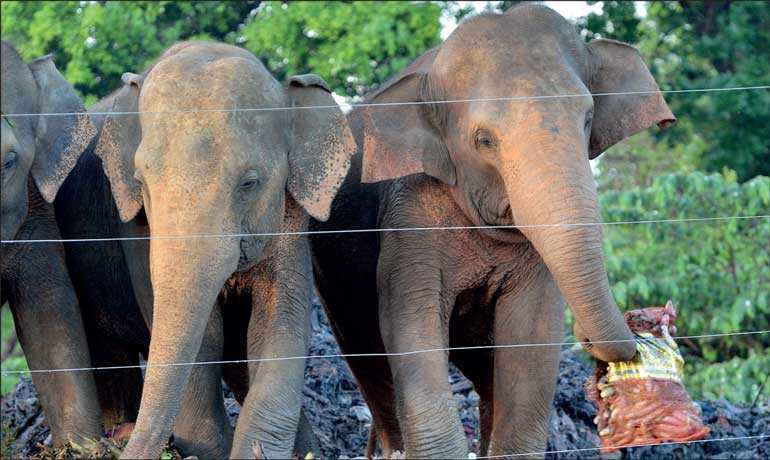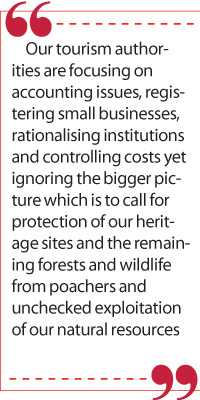Monday Feb 24, 2025
Monday Feb 24, 2025
Saturday, 12 September 2020 00:08 - - {{hitsCtrl.values.hits}}

There has never been a greater need than now for the formation of a green movement in Sri Lanka dedicated to preserving our natural heritage and wildlife – Pic by Shehan Gunasekara
By Dr. Sarala Fernando
The Wildlife and Nature Protection (WNPS) President’s recent message revealed shocking data on the state of Sri Lanka’s environment and wildlife.
From the Mount Lavinia beach nourishment project which turned into a “colossal disaster” to the rare black panther which suddenly appeared only to be “snared and killed in a terrible manner” to the several leopard deaths due to snares and forest clearing, “tuskers felled in quick succession” while other elephants succumbed to different unnatural deaths, while Vidattaltivu Nature reserve is being cleared and Yala turned into a “drive-in animal farm” where private jeeps were allowed to go in unsupervised”.
Relentless destruction
The irony is that during all the years of the armed conflict, it seems nature and wildlife suffered less destruction! During 2006 during the height of the armed conflict, HEC resulted in the deaths of 24 humans and 66 elephants, while in 2019 when the country was enjoying the benefits of peace, there were 361 elephants killed, the highest since Sri Lanka became independent in 1948. 
Now from the Puttalam mangrove islands to Vidattaltivu to Anawilandawa to Hantane it seems mangroves, forests and nature reserves are being cleared mercilessly.
Yet Sri Lanka goes on advertising images of elephants and leopards in its tourism campaigns – but foreigners are not fooled and already the country image is being tarnished internationally by the high animal deaths and the inability of the Government officials to control the killing. Just look at the criticism on social media against Sri Lanka and compare with the pristine beaches and marine life offered by our competing neighbour Maldives.
Our tourism authorities are focusing on accounting issues, registering small businesses, rationalising institutions and controlling costs yet ignoring the bigger picture which is to call for protection of our heritage sites and the remaining forests and wildlife from poachers and unchecked exploitation of our natural resources.
Renton de Alwis during his tenure as Head of Tourism started a ‘Green Lung’ campaign to encourage hoteliers to work for environmental protection in their surroundings, cleanliness and hygiene, while also working in tandem with the local communities. This is a message that responsible local companies like Aitken Spence and Jetwing have taken to heart in developing their properties.
Wildlife killings
There is another point and that is whether media publicity is in fact causing adverse consequences among the local communities on the ground. Take for example the story of the emergence of the rare black panther and its subsequent killing in a short time.
While the news was first broken by researchers from the Wildlife Department and drew some excitement in the press and educated circles, is it possible that it sent shivers at the local level in the affected areas, causing them to put up more and more snares to kill the beast? Is there a gap between the needs of the researchers to put out their research for example on leopards to sensitise the public but instead does this create panic in the affected local areas which is driving the resort to snares and causing more animal deaths?
Virtually every evening TV broadcasts feature the damage caused by elephants and by doing so are they unsuspectingly encouraging more humans to resort to violence against these majestic beasts? The Wildlife Department need to be restructured, assigning less importance to desk research and more to the field and releasing more resources from administration to hands on protection and management on the ground.
International animal parts trade
There is another possible angle and that is even more worrisome, that Sri Lanka is getting caught up in the international animal parts trade.
Following the COVID-19 outbreak and the evidence of transmission of the virus from animals to humans, the Chinese Government has banned live animal farms and markets as has also neighbouring Vietnam and even mink farms in Europe, however there are reports to suggest that the illegal trade has been driven to developing countries with poor protection measures and unscrupulous elements are engaged in the trade of bones, claws and teeth from poached wildlife.
Recently a leopard body with its teeth and claws removed was found near Yala so this is not entirely improbable. Since the Wildlife Department has now found and removed several traps set for leopards in the tea country, they will be able to detect whether these are being manufactured and distributed widely, or whether they are just randomly constructed.
Even more worrisome would be if Government officials are involved, not impossible given the recent discovery of Narcotics Bureau Police being involved in the lucrative sale of seized drugs. Not so long ago department officers were found to have doctored the domestic elephants’ records directly involving them with a racket to steal baby elephants from the wild for sale.
In many of these cases it is young activists in the field who have exposed the crimes at considerable risk to themselves. Even in the case of the destruction of mangroves in natural reserves in the Puttalam area, young women like Devyani and Sevvandi are standing up against the destruction of the mangroves by local politicians.
Need for a green movement
There has never been a greater need than now for the formation of a green movement in Sri Lanka dedicated to preserving our natural heritage and wildlife. Yet the irony is that in this predominantly Buddhist country the monks should be taking the lead in calling for compassion for the animals, for an end to animal sacrifice and humane treatment of all animals including those going to slaughter.
Amidst all the gloom, the only ray of sunshine is the recent Government decision to repair and restore the tanks in Yala and grow grass for the elephants to feed on as a means to keep them within the reserves.
As climate change sets in, governments will have to do more for conservation and look for new solutions to protect wildlife. In Thailand, one elephant centre deprived of funds during the lockdown went out to the nearby banana plantations and used that as fodder once the fruit was harvested; in South Africa, when elephants stray from the reserves, they have used horse pellets, dropping sacks of them on the way to entice the elephants back into the reserve.
Someday soon there will be a need to find additional food sources to keep these animals within the reserves and the vets should be looking into these solutions, drawing upon the possibility of growing nutritious substitutes in the surrounding villages and thereby helping the villages also.
Discover Kapruka, the leading online shopping platform in Sri Lanka, where you can conveniently send Gifts and Flowers to your loved ones for any event including Valentine ’s Day. Explore a wide range of popular Shopping Categories on Kapruka, including Toys, Groceries, Electronics, Birthday Cakes, Fruits, Chocolates, Flower Bouquets, Clothing, Watches, Lingerie, Gift Sets and Jewellery. Also if you’re interested in selling with Kapruka, Partner Central by Kapruka is the best solution to start with. Moreover, through Kapruka Global Shop, you can also enjoy the convenience of purchasing products from renowned platforms like Amazon and eBay and have them delivered to Sri Lanka.
Discover Kapruka, the leading online shopping platform in Sri Lanka, where you can conveniently send Gifts and Flowers to your loved ones for any event including Valentine ’s Day. Explore a wide range of popular Shopping Categories on Kapruka, including Toys, Groceries, Electronics, Birthday Cakes, Fruits, Chocolates, Flower Bouquets, Clothing, Watches, Lingerie, Gift Sets and Jewellery. Also if you’re interested in selling with Kapruka, Partner Central by Kapruka is the best solution to start with. Moreover, through Kapruka Global Shop, you can also enjoy the convenience of purchasing products from renowned platforms like Amazon and eBay and have them delivered to Sri Lanka.